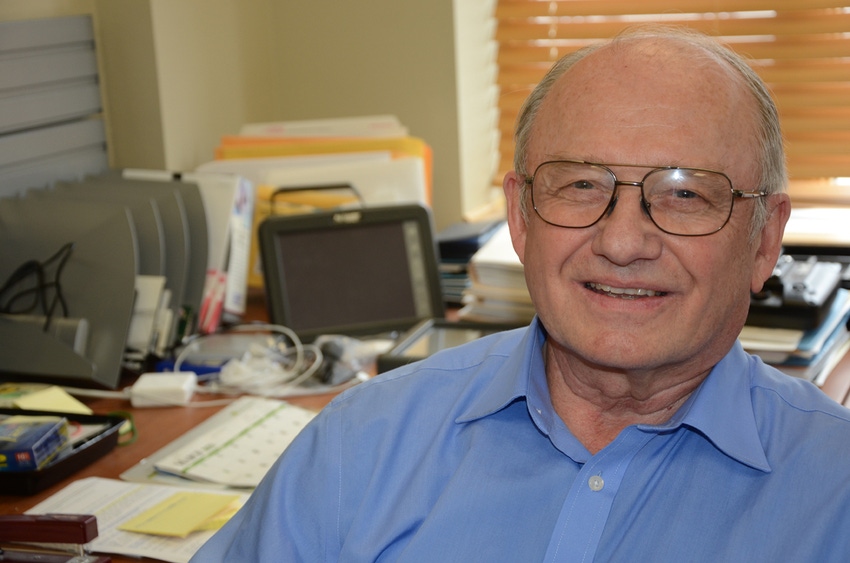May 11, 2015

Al Myers is an unassuming man who looks just like you would expect a farm boy ag engineer from eastern Illinois to look. He’s quick to laugh at a joke, and in his quiet way lets you know he has a keen understanding of this industry. Myers is the pioneering engineer who brought out the on-the-go yield monitor from the company he created — Ag Leader.
Did you realize what you’d started when you created the yield monitor?
No, not really. Certainly I didn’t realize where it was all going when I created the on-the-go yield monitor. I thought it would be useful information for farmers at some point in time. Certainly farmers knew there was variation in their fields, but the big surprise when farmers started using yield monitors — there’s large variations you can’t see visibly from the combine seat in the field.
It’s probably less today because farmers have worked to eliminate some of the reasons for those variations. But in the beginning in 1992, it was not at all uncommon to see close to 2-to-1 yield variations going across a field, and you really couldn’t see it visually from the size of the stalks and that kind of thing.
What were you doing before?
I’m an ag engineer by training, grew up on a grain and livestock farm in eastern Illinois, got my degree at the University of Illinois, B.S. and master’s in ag engineering. I started out of college working for a small hydraulics division of Sundstrand Corp. in Rockford, Ill. I really wanted to work for Cat or John Deere; they were my target employers, but they weren’t hiring that year [he chuckles]. I was about ready to leave that job until I got transferred out to the hydrotransmission plant [in Ames, Iowa]. It’s now Danfoss.
That was a lot of fun for the first 10 years or so. They were growing fast, and there was a lot of opportunity to develop new products. And that’s what I like to do. Then the terrible recession in off-road machinery in both agriculture and construction hit them, and a lot of companies, really really hard.
I didn’t enjoy what I was doing in the mid-1980s, so I started brainstorming — what could I do to develop a product and start my own company? The more I looked at it, the more I felt that an on-the-go yield monitor was just inevitable.
How did you work through those early problems for yield monitors? Today, some things seem obvious, but not back then.
I brainstormed a lot of different ways of where on the combine, and how you could capture and measure the grain flow to create a yield monitor. And actually, I started down one track that, after a few months I quickly decided, that’s not going to work, or I didn’t know how to make it work.
Here’s a mechanical concept, the one we use today and others have used it as well, and it just might work. I spent six years working through the various problems in figuring out how do you make this measure grain flow accurately?
What does the cloud mean for Ag Leader today?
Well, certainly there’s this term I’ve started seeing recently: the Internet of things. It seems like any new products — whether your car, your farm machinery, your appliances at home, all that kind of stuff — seem to be getting connected on the Internet.
Our products create massive amounts of information today that has to be moved on memory sticks. In the old days it was disks and memory cards and so on. We’re rapidly moving toward moving that data around wirelessly and people having access to their data wherever they are through their smartphone, their iPad and those kinds of things.
You work with OptRx, for real-time crop sensing. Where do you see that technology going?
I still feel it’s the way of the future. One of the struggles we’ve had with that is people out there who think it’s “black magic.” Does it really work? You just shine some light on a plant, and it tells you what it needs? Certainly from an adoption standpoint, one of the barriers is farmers don’t have the machinery to be able to sidedress when corn is tall.
Where we’ve actually seen the best acceptance is Europe, where they intensively grow wheat and barley and those kinds of crops. They already have the equipment, because over there, in wheat, they’ll fertilize it two or three times a year while it’s growing.
Looking back to the beginning, what was it like to start a company, and then later, generate that first yield map?
Great sense of satisfaction for sure. I can even remember, 1994, the first year we recorded the data on a card, Ted Macy [founder of Mapshots] was selling some GPS-in-a-box thing back then. I put it on my dad’s combine, and the first time you get real yield maps on your own family’s farm — wow! This is something!
What do you see for yourself in the next decade?
Not looking to retire. I’ll be 67 years old this summer, old enough to retire. Like an old farmer, I want to keep going. I have to give it up someday; I’ve done a lot over the last several years to develop a good management staff here. I probably would not have made it as far as I have if I had not worked in a medium-size business. So I did know how business worked, so to speak.
Like what you’re reading? Subscribe to Farm Industry News Now e-newsletter to get the latest news and more straight to your inbox twice weekly.
About the Author(s)
You May Also Like






